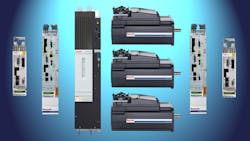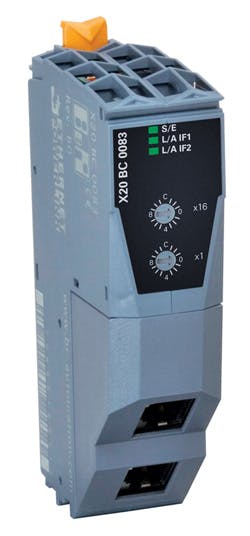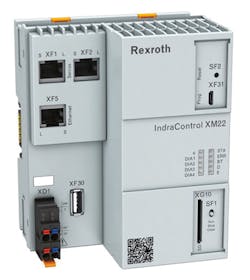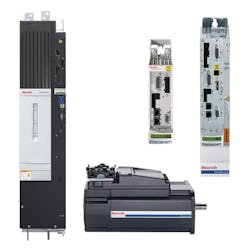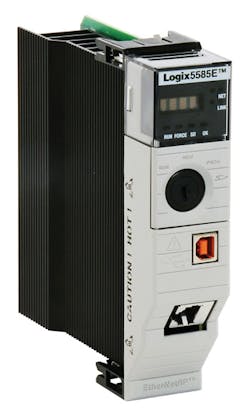As companies look to bring more manufacturing to the U.S. or keep work here, automation and robotics are increasingly being used in factories. This has accelerated the development and use of electronics and software as more manufacturing equipment is focused on automation and robotics. So where are these new advanced control devices headed? In short, products are increasing modularity, flexibility, programming, and connectivity. This article will explain how some companies are making this happen, and some of the products that make it possible to satisfy and implement these four trends.
1. Modularity
The first trend that can be traced back to the invention of standardized parts is modularity. Expensive custom machines offer fewer benefits and cost advantages, which is why large custom products are reduced to important systems. This lets engineers select just the hardware needed for a type of mix-and-match or Frankenstein approach. As automation advances or changes, small components are able to be swapped out to allow for more cost-effective integration of new technology.
Modularity is good for changing and upgrading lines, but has caused some problems in future-proofing. Often, proprietary systems force companies to return to the same OEM each time they want to add features to a line. Having one provider for hardware or software does help to streamline some processes. Machine-control solutions should be based on internationally recognized standards for a number of reasons, according to B&R Industrial Automation. If proprietary equipment doesn’t offer flexibility to upgrade, change, or seek an outside company to do so, using this type of equipment could impede development. Companies are finding benefits in opening up hardware to accept open-source networks and safety protocols. With an open modular design, companies don’t have to build things from scratch just to satisfy customers. This means modular units may have changeable options, variable drives, or swappable features. This can be a challenge for safety certifications and operations. It is possible to join machines from different vendors in a single safety network, but this may require extensive programming on the floor. And any time programming is changed, the safety applications will have to be rechecked and possibly reprogrammed.
B&R Industrial Automation is among the many industrial control suppliers using the OPC UA (Open Platform Communications Unified Architecture) communications standard. At last year’s Hannover Messe, B&R announced the development of the world’s first field device for OPC UA. The X20 I/O system bus controller allows OPC UA communication from the sensor layer to the Enterprise Resource Planning (ERP) layer without any interfaces.
“For example, the X20BC008U controller functions as an OPC UA server and provides all information about connected I/O modules to OPC UA clients from any manufacturer,” says John Kowal, director of business development for B&R. “This includes controllers, SCADA systems, ERP systems, or cloud applications. Interfaces, gateways, and the associated loss of information are a thing of the past. All production process data is transferred using a single protocol. With the new OPC UA publish-subscribe model, data can be distributed efficiently.”
Integrating networked safe motion can offer production benefits as well. For example, if a fault occurs, a machine or line can continue running in a safe mode while service is performed. B&R also makes the networked safety standard it developed through the Ethernet POWERLINK Standardization group, openSAFETY, available as an open source protocol.
2. Flexibility
While modularity often refers to the physical hardware, flexibility seems to reference software. Modern automation equipment is driven more and more by software. Flexibility is often used to reference the ease of changing software by using multiple languages, open-source resources, and generally communicating with any software that is being used on the hardware.
Once installed, hardware—even modular—is difficult to change compared to software. It could be argued that since the inception of PLCs, there has been a movement toward more software-controlled systems. With the move to higher language programs, this trend has accelerated. Software control can offer features like variable speeds and remote maintenance. It also can streamline development of the Industrial Internet of Things (IIoT). Interfacing with a machine through software also offers more communication. Technicians can enter text, have changeable graphics to communicate, or use touchscreens for higher-quality human-to-machine interfaces (HMIs).
Hardware can’t be eliminated, but the trend to consolidate it or replace it with software anywhere possible will continue. There is a common thread in both hardware and software, and that is that open-source is driving it. For example, Bosch Rexroth is using a combination of PLC and modern IT to provide flexible software solutions. Called Open Core Interface, it is opening up software and firmware to allow users to use any programming language they are comfortable with, or is needed to accomplish a goal. Just to be clear, firmware is software that is built into the hardware that is often not easy, or not possible, to change. But with the open-source trend, everything seem negotiable. Manufacturing equipment today must keep up with the concurrent entry of new IT technologies in automation.
“People starting in automation need to know what features to look for,” says Matteo Dariol, product developer for Bosch Rexroth. “Software flexibility is important. Even if something is wrong, or needs regular upgrades, having flexible open software can fix most issues quickly and inexpensively. By opening everything to the core and being able to use multiple and higher-level languages, we are moving toward hardware that is capable of a new approach to a custom automation programming world.”
3. Programming
Programming is often not familiar to mechanical engineers. Even when PLC started in the 1970s, electric engineers (EEs) often programmed them. Having EEs programming PLC led to a logical flow from electrical diagrams to ladder logic. For years, ME programs included ladder logic programming, and some still do. Recently, however, students are using python with an Arduino for their college projects. Some are graduating without ever learning or seeing ladder logic. “I graduated in 2008 and I never saw ladder logic until my first job,” notes Matteo. “However, ladder logic will not go away … but companies are moving toward higher-level languages such as C-#, C++, or Java.”
While ladder logic is cemented in the industry, some engineers say it is shrinking and other languages are becoming popular. This may be a shift in mechanical engineering (ME) education. In order to keep up with growing electronics and programming skills, ME programs need to consider incorporating a programming class. This could start with ladder logic, but should incorporate higher-level languages as well.
Engineers already out of school may want to consider looking into classes or online resources. MEs seem to be starting with many Windows-based programs because they’re easy to learn. By expanding beyond ladder logic, more advanced features in automation and robotics are possible or easier. With Open Core, for instance, engineers are able to use a language they are comfortable with—ladder logic, Java, C++, etc. After the language is selected, Bosch Rexroth provides the application program interface (API) for the software interfaces.
“Companies should come up with standards for their automation software,” says Matteo. “Just because you can use multiple languages doesn’t mean you should. You don’t want to have more than one or two languages in a system or plant. The trend of having open resources is so engineers can use the tool that they are more comfortable with, not to use all the languages.” This presents new challenges, as mechanical engineers may have to work with languages they have never heard of or seen before. For example, Lua is used for games. It is a scripting language similar to python that is starting to show up in robotic applications. This shouldn’t be cause for alarm. Rather, it should be a cause for companies to invest in its engineers for continued training and education.
If you are an engineer already in the field, it can be difficult to know where to start in programming. Start small and with minimal investment and build up. There are many programming resources online, and many of them are free: Code Academy, Code School, Udemy, Khan Academy, Coursera, and even some open courseware from MIT. Don’t be overwhelmed at the amount of resources. Find a website you like or just pick one and get started. (A bit of advice: If you are going to simply pick one, make sure it’s a free one. There is no point in investing money if you don’t know if the education is worth it, or free somewhere else.)
The amount of classes and languages can also be overwhelming. Check with your company’s control engineers or IT department for help. Lacking this, Java or C-# can provide a starting point. If you happen to have Web-based applications, HTML or Java Script can provide a good starting point (Java and Java Script are not the same). However, once you start to understand how programming works, you don’t have to be an expert. Knowing basics can greatly help your proficiency in understanding and working with these new products.
4. Connectivity
Even a rough understanding of programming will give you insight into how many of these new products are communicating with other devices and networks. “At shows, I have seen more of an interest in offering more types of architectures and languages,” says Matteo. “Part of the reason for this is to streamline languages and programs. As the IoT expands, using a language such as HTML for Web applications [PLC and HMIs] reduces the amount of languages a control engineer needs to know. In addition, it helps communication between different hardware components.”
Communication between humans and machines is important. Studies have confirmed that the brain processes information with images more quickly than text. This might explain the growth of graphical user interfaces (GUIs). For example, the icons for your apps on your phone are GUIs. With high computer languages like HTML, better graphics are possible. Another benefit is that HTML is much of what we see on the internet today, making it possible to interact with an HMI the same way as our laptops and phones. Higher languages, in general, can offer notes to be entered directly on the HMI, which can help with documentation.
In addition, improving communications between PLC, PC, and Web-based applications improves connectivity and can therefore streamline IIoT development. For example, a PC could use Java, a PLC could use ladder logic, and a Web application could use HTML. Many companies are starting to integrate software that uses scripted languages with Java and HTML with advanced graphics that are also able to communicate with ladder logic. A PLC today might also look like it is ladder logic on the readout or HMI, but could have a source code of a scripted language. This is helping to keep the best of both worlds, and communicate to engineers familiar with ladder logic while providing advance features necessary for IoT and robotics. In addition, working with HTML5 and Java script can give direct access to control functions with different end devices (such as smartphones or tablets) without increased programming. This simplifies the development of Web-based diagnosis, visualization, or analysis apps.
Rockwell Automation is another player driving this trend. It has been offering connectivity for its controllers and VFDs so that operators can gain more insight into their operations. Drives that offer advanced predictive diagnostics that can estimate the remaining life span of drive components, such as fans, relay contacts, power semiconductors and capacitors, allow users to actively monitor parameters, such as temperature and runtime, of the drive and motor to allow for preventive action if necessary.
By having higher language software that streamlines connectivity, controllers are also able to handle more applications and axes of motion. Some of Rockwell Automation’s new controllers, such as the ControlLogix 5380 and 5580, are able to deliver anywhere from 20% to 45% more application capacity and 20 to 256 axes of motion.
“Connectivity is moving toward more Ethernet, wireless, and open-platform communications,” says Greg Gernert, business manager for Logix controllers at Rockwell Automation. “Open platforms are connecting different systems that share data. This is important to move the data into the processor and up to the MES [manufacturing execution system] and ERP [enterprise resource planning] systems. Then you have that data across the enterprise. The main trend from my standpoint is around data collection and EtherNet/IP being native on the controller.”
Offering more open source in modularity, flexibility, and connectivity can add features and improve productivity, but it is important to remember future developments. While there is a lot of talk about bandwidth in future-proofing, there are technologies that can handle high bandwidths, such as Rockwell Automation’s 1-gigabit Ethernet ports in its newest Logix controllers. What is more important is to know where data is needed. For example, temperature sensor data can be processed locally and does not need to go to the cloud. For information that is sent all the way to the cloud, timing is important. If the data isn’t time-sensitive and updating it every hour will not make a difference, there is no reason to send the data every second. This analysis will help clear bandwidth, and promote better processing.
Making sure you have open options, enough bandwidth, and only send necessary data in a timely manner may sound like common-sense project management. But you need to consider all of these points to ensure that you have a plan for the future. Without a plan for the hardware and software that runs the machines, you will find plenty of annoying upgrades or problems that were preventable. This is if you’re lucky and don’t run into big, expensive problems that result in replacing equipment that isn’t close to finishing its lifecycle yet, and not scheduled into the budget.
Ultimately, if you have a grandfathered system that runs widgets that have been unchanged for years with no plans on changing, this might not be a concern—for example, manufacturing Twinkies. Otherwise, you might want to consider automation in the future plans of your production. If you are considering this, hardware modularity, software flexibility, and overall connectivity ability are all important features. And they all seem to have one trend driving them—open source, or the ability to be patched into some type of open platform.
